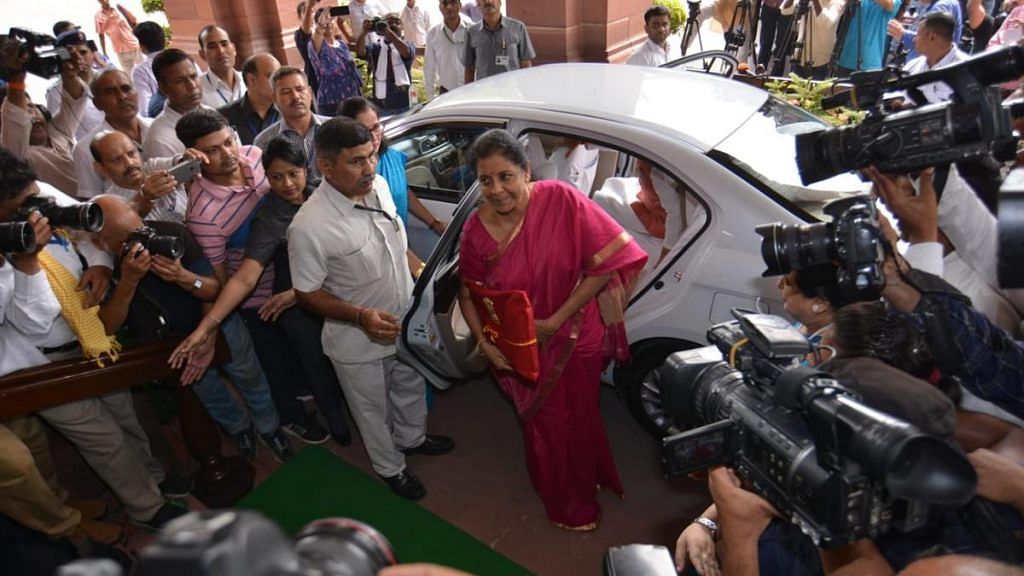New Delhi: Presenting her first Union Budget Friday, Finance Minister Nirmala Sitharaman broke with over a century-old tradition, abandoning the traditional leather briefcase containing the Budget speech, which all her predecessors had been seen carrying on this day.
Instead, she brought the documents wrapped in a four-fold red cloth, with Chief Economic Adviser Krishnamurthy Subramanian telling ANI: “It symbolises our departure from the slavery of Western thought. It is not a budget but a bahi-khata (ledger).”
Many Right-wing politicians and supporters hailed the move on social media.
The Changing Tradition #Budget2019 #IndianTradition pic.twitter.com/GCK6FmhJsA
— Harsh Sanghavi (@sanghaviharsh) July 5, 2019
From the traditional briefcase held by male Finance Ministers to the #BahiKhata beig introduced by India's first full time woman FM – the very erudite Niramala Sitharaman 🙂 Love it pic.twitter.com/WOhOkjOUR9
— Shehzad Jai Hind (@Shehzad_Ind) July 5, 2019
This wasn’t Sitharaman’s only break from tradition — she untied the red ribbon on the budget documents during the halwa ceremony, rather than cutting the ribbon, as used to be done in the past. MoS Anurag Thakur and Finance Secretary Subhash Garg also did the same.
Also read: Even after Balakot air strikes, defence budget remains unchanged at Rs 3.18 lakh crore
The briefcase and other colonial carry-overs
The first budget of India was presented by James Wilson, finance member of the India Council on 18 February 1869. The council was meant to advise the Viceroy of India on the outlay of revenue and expenditure concerning the colony.
Until 1947, the budget was presented in the British Parliament. R.K. Shanmukham Chetty presented independent India’s first budget on 26 November 1947, entering Parliament with a briefcase in hand, emulating a British tradition that began nearly a century ago.
The word ‘budget’ originated from the French word ‘bougette’, which translates to leather bag. And in 1860, the Chancellor of the Exchequer (the British equivalent of the finance minister) William E. Gladstone used a red leather briefcase with Queen Victoria’s monogram in golden letters.
Gladstone had also begun the tradition of posing for a photo-op holding up the briefcase outside the Chancellor’s official residence, 11 Downing Street, before proceeding to Parliament for the budget speech. However, the red ‘Gladstone briefcase’ was discontinued in 2010, and George Osborne unveiled a new budget box outside 11 Downing Street in 2011.
The tradition of presenting the budget at 5 pm on the last working day of February was also a carry-over from the British Parliament. John Mathai presented the first budget of the Republic of India at 5 pm on 28 February 1950, and every subsequent finance minister followed suit until 2001 when, under Atal Bihari Vajpayee’s NDA regime, Yashwant Sinha began the tradition of presenting it at 11 am.
The Modi government changed the ‘end of February’ tradition in 2017 when Arun Jaitley began presenting the budget on 1 February.
Halwa ceremony
There’s another unusual tradition associated with the Union Budget — the halwa ceremony, which precedes the printing of the budget documents. The finance minister serves halwa to the officials and ministry staff who are involved in the preparation and printing of the budget, and Sitharaman did observe this one.
The budget documents are printed in top secrecy at North Block, which serves as the office of the finance ministry. Officials involved in the printing of budget remain in the basement with no contact with the outside world until the finance minister concludes his/her budget speech in Parliament.
The office of MoS Finance Anurag Thakur had tweeted this as a fun fact:
FunFact:
The #UnionBudget is printed within the north block, those engaged in the process cannot leave the building till it is presented in the Parliament.
Pic: Armed Personnel guard copies of #UnionBudget2019 pic.twitter.com/cTYpvQ16E2
— Office of Mr. Anurag Thakur (@Anurag_Office) July 5, 2019
Also read: Modi govt wants more Muslims in IAS & IPS, raises budget for free UPSC coaching
Interesting facts about the Union Budget
- Morarji Desai has presented the highest number of budgets (10). But he didn’t present any of those as prime minister.
- Three PMs have presented the budget while holding the finance portfolio — Jawaharlal Nehru, Indira Gandhi and Rajiv Gandhi.
- A secret piece of paper known as ‘Blue Sheet’ is maintained throughout the budget preparation process. This contains all the significant numbers from the budget and is constantly updated throughout the process of budget formulation. The person responsible for secrecy is a joint secretary in the finance ministry.
- On the day of the budget, the finance minister first visits Rashtrapati Bhavan to apprise the President on the main points of the budget.
- Initially, the budget documents were printed at Rashtrapati Bhavan, but following a leak in 1950, the process was shifted to Delhi’s Minto Road. It was shifted to the North Block basement in 1980.
